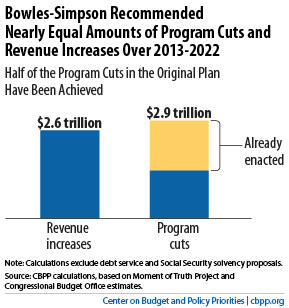off the charts
POLICY INSIGHT
BEYOND THE NUMBERS
BEYOND THE NUMBERS
Our new report — What Was Actually in Bowles-Simpson? — has the details, but below are five basic points about the budget plan from presidential deficit commission co-chairs Erskine Bowles and Alan Simpson.
- Bowles-Simpson called for $6.3 trillion in deficit reduction over fiscal years 2013-2022. That figure consists of $5.5 trillion in policy savings and about $800 billion in interest savings.
- The $5.5 trillion in policy savings consists of 53 percent budget cuts and 47 percent revenue increases, or almost a 1-to-1 ratio. In dollar terms, Bowles-Simpson calls for almost $2.9 trillion in program cuts and almost $2.6 trillion in revenue increases. This nearly 1-to-1 ratio does not include the interest savings. If one counts interest savings as a spending reduction, we get a 1.4-to-1 ratio of program cuts to revenue increases.
- Policymakers have already enacted about half of Bowles-Simpson’s nearly $2.9 trillion of program cuts. Because of the caps on discretionary funding in last year’s Budget Control Act (BCA), discretionary spending will be $1.5 trillion lower over 2013-2022 than under the Congressional Budget Office’s August 2010 baseline (the baseline in use when the Bowles-Simpson commission deliberated). Including the associated interest savings, the total budget savings reach $1.7 trillion.
- The majority of the savings in Bowles-Simpson that haven’t yet been achieved is on the revenue side. Excluding the enacted savings, the Bowles-Simpson plan would achieve an additional $4.6 trillion in deficit reduction over ten years, consisting of $1 in program cuts for every $2 in revenue increases.
- The $4.6 trillion in additional deficit reduction under Bowles-Simpson is more than twice what is needed to stabilize the debt as a share of the economy. As policymakers consider various deficit reduction packages, they should keep in mind what various amounts of deficit reduction will achieve in terms of managing the national debt. They should also be aware of the mix and nature of program reductions and revenue increases used to achieve these goals. The challenge will be to strike the right balance.
Image

Topics:
Stay up to date
Receive the latest news and reports from the Center
